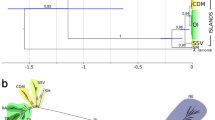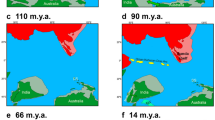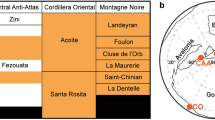Abstract
THE existence of the same species in countries widely separated by oceans, an apparent exception to the hypothesis of single centres of creation, was explained by nineteenth century naturalists in two ways: by transoceanic dispersal or by continental extension. Darwin supported the first explanation, and argued against major continental extensions so recent as to be “within the period of existing species”1. Explanations by continental drift can be criticized on the same grounds2. But in most widely dispersed species we still lack detailed knowledge of the seed and its means of dispersal. Thus the possibility of long-distance dispersal by ocean currents of seed of certain species of Sophora (Papilionaceae) has long been discussed. Studies of S. tomentosa, a pan-tropic littoral species with buoyant seeds, show that this species must certainly be distributed in this way3–5; and since Darwin's time there has been speculation as to whether the close relation between the sophoras of New Zealand, southern Chile and Gough Island can be explained in the same way. We made the following observations on the problem on the Kermadec Islands (W. R. S.) and in New Zealand and southern Chile (E. J. G.).
This is a preview of subscription content, access via your institution
Access options
Subscribe to this journal
Receive 51 print issues and online access
$199.00 per year
only $3.90 per issue
Buy this article
- Purchase on Springer Link
- Instant access to full article PDF
Prices may be subject to local taxes which are calculated during checkout
Similar content being viewed by others
References
Darwin, C., On the Origin of Species, first ed. (Watts and Co., London, reprint, 1950).
Godley, E. J., Nature, 214, 74 (1967).
Schimper, A. F. W., Die Indo-malayische Strandflora (Gustav Fischer, Jena, 1891).
Guppy, H. B., Observations of a Naturalist in the Pacific, 2, Plant Dispersal (Macmillan and Co., London, 1906).
Guppy, H. B., Plants, Seeds and Currents in the West Indies and Azores (Williams and Norgate, London, 1917).
Hair, J. B., and Beuzenberg, E. J., NZ J. Bot., 4, 266 (1966).
Wace, N. M., and Dickson, J. H., Phil. Trans. Roy. Soc., B, 249, 273 (1965).
Skottsberg, C., Proc. Roy. Soc., B, 152, 429 (1960).
Skottsberg, C., in Essays in Geobotany (University of California Press, 1936).
Wyrtki, K., Div. of Fisheries and Oceanography. Tech. Paper No. 8, CSIRO, Australia (1960).
Holdgate, M. W., Mountains in the Sea (Macmillan and Co., Ltd, London, 1958).
Oliver, W. R. B., Trans. NZ Inst., 42, 156 (1910).
Mason, R., Nature, 191, 408 (1961).
Cooper, R. C., Rec. Auck. Inst. and Mus., 6, No. 3, 171 (1967).
Author information
Authors and Affiliations
Rights and permissions
About this article
Cite this article
SYKES, W., GODLEY, E. Transoceanic Dispersal in Sophora and other Genera. Nature 218, 495–496 (1968). https://doi.org/10.1038/218495a0
Received:
Revised:
Published:
Issue Date:
DOI: https://doi.org/10.1038/218495a0
This article is cited by
-
Potential plant genetic resources of the New Zealand flora
Economic Botany (1990)
-
Aerial dispersal of biological material from Australia to New Zealand
International Journal of Biometeorology (1978)
Comments
By submitting a comment you agree to abide by our Terms and Community Guidelines. If you find something abusive or that does not comply with our terms or guidelines please flag it as inappropriate.



